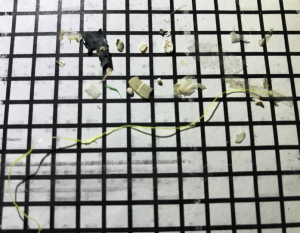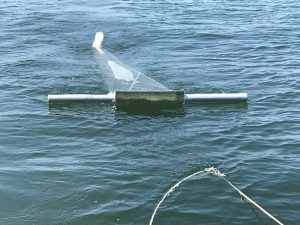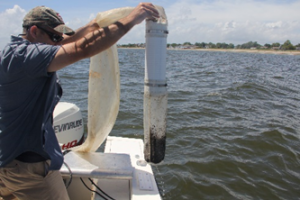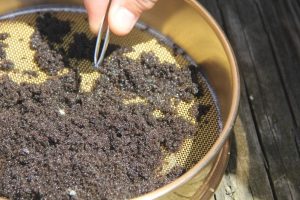Microplastics are an often unseen but growing threat to the world’s soil and water. The Oxford English Dictionary defines them as “Extremely small pieces of plastic debris in the environment resulting from the disposal and breakdown of consumer products and industrial waste,” and many scientists specify they’re pieces of plastic smaller than 5 millimeters (mm). To give you an idea of what this looks like, below are plastic pieces trawled from Sound waters off of Lordship, Stratford, on a grid where each cell is 5 mm2.
In an effort to understand the scope of the microplastic problem in Long Island Sound, Soundkeeper Bill Lucey of Save the Sound requested a manta trawl through the EPA equipment loan program in 2018. The microplastic citizen science program is in its initial stages and Save the Sound is the second group to test the equipment.
To tow the trawl, a donated aluminum boom was welded and installed on the Soundkeeper’s patrol boat by Derecktor’s Boat Yard in Mamaroneck, NY. (A special shout out to Derecktor’s manager, Micah, for his help!)
The manta trawl is towed through the water at low speed and water passes through the opening, with plastics and other material becoming trapped in the collection end. Several volunteers assisted sorting through the algae, jellyfish, and tiny juvenile Asian shore crab to quantify the amount and type of plastics.
HOW BAD IS IT OUT THERE?
The first step to approaching any problem is to define the scope. Unfortunately, the scope of the microplastics problem in Long Island Sound appears substantial. The University of Connecticut has estimated the Sound holds 5,000 microfibers per cubic meter, and every time a manta trawl was deployed this summer it harvested various types of microplastics from the surface.
This manta trawl pilot project focused on the greater Bridgeport area, which contains several Combined Sewer Overflows, two treatment plants, and three rivers and streams bringing trash into the near coastal waters.
This table summarizes the catch from 2018. For each category, the first number represents plastic pieces less than 5mm and the second pieces larger than 5mm. There are several other, scientifically rigorous initiatives looking at the issue already underway in Connecticut:
There are several other, scientifically rigorous initiatives looking at the issue already underway in Connecticut:
-
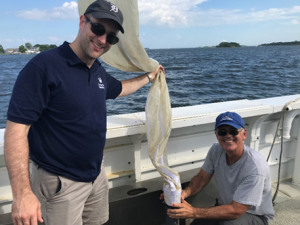
Dr. Breslin (Southern CT Univ.) and Dr. Hudson (Norwalk Maritime Aquarium) sampling microplastics in the Norwalk Islands this summer. UCONN Storrs lab works in Greenwich, CT with the Atlantic Clam Company investigating shellfish interactions with microplastics.
- UCONN Avery Point’s microfiber work has spanned ten years and has found an average of 5,000 microfibers per cubic meter of water in Long Island Sound.
- Southern CT University’s Breslin Lab is analyzing microplastics from Norwalk Harbor as well as effluent from sewage treatment plants and shellfish in river systems.
- US Geological Survey collected microplastics and fibers from the Connecticut River by deploying a stationary plankton net in 2017.
SO WHAT CAN BE DONE?!
In 2018, then-state Senator Ted Kennedy, Jr. put forth and passed legislation establishing a statewide microfiber working group. This group included researchers, industry and trade group representatives, agency staff, and environmental advocates including the Soundkeeper.
The group met twice in the fall of 2018 and there is a draft report from Connecticut Department of Energy and Environmental Protection summarizing the issue and possible solutions to microfiber pollution from clothing. We will link a copy of the report to this blogpost once it is finalized.
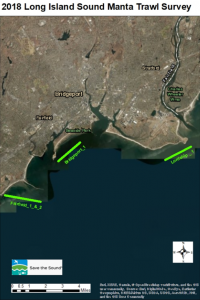 In the meantime, there are many other things we can all do to start eliminating the scourge of plastics on our planet.
In the meantime, there are many other things we can all do to start eliminating the scourge of plastics on our planet.
- Reduce or eliminate non-critical single use plastic (straws, plastic bags, unnecessary packaging)
- Use biodegradable materials such as paper bags, straws, paper packing material
- Put filters on washing machines to catch fibers shed from clothing
- Recycle all plastic containers
Here is some more reading on recent efforts to deal with plastics.
Governor Cuomo’s statewide efforts: Cuomo’s proposal to ban plastic bags expand NY’s bottle bill
Norwalk unanimously passes its bag ban: Norwalk votes to ban single use plastic bags
How to reduce your own impact: OceanCleanWash.org
Momentum is building globally to finally take on this problem.
Thanks to all of you pushing for solutions—let’s keep it up!

